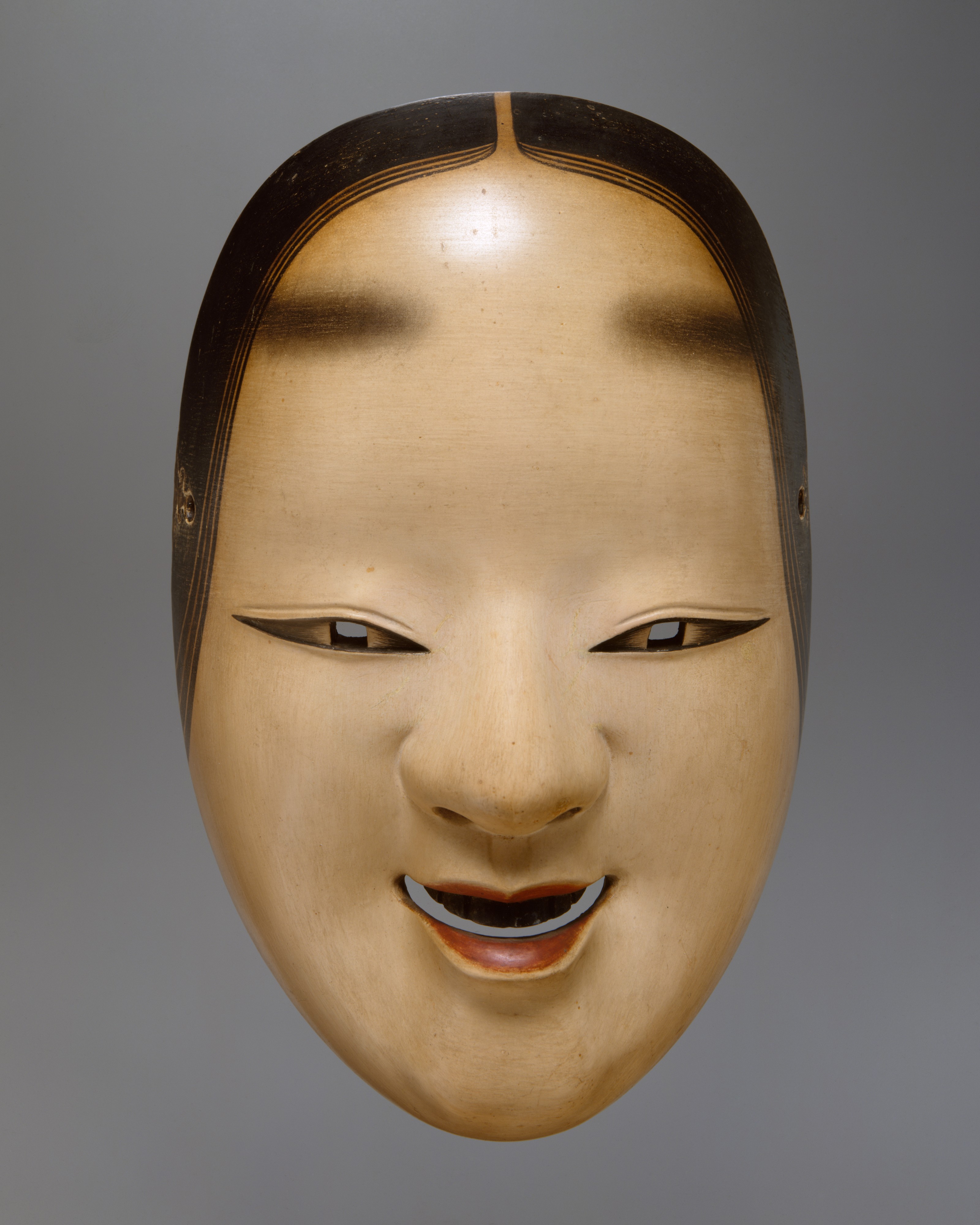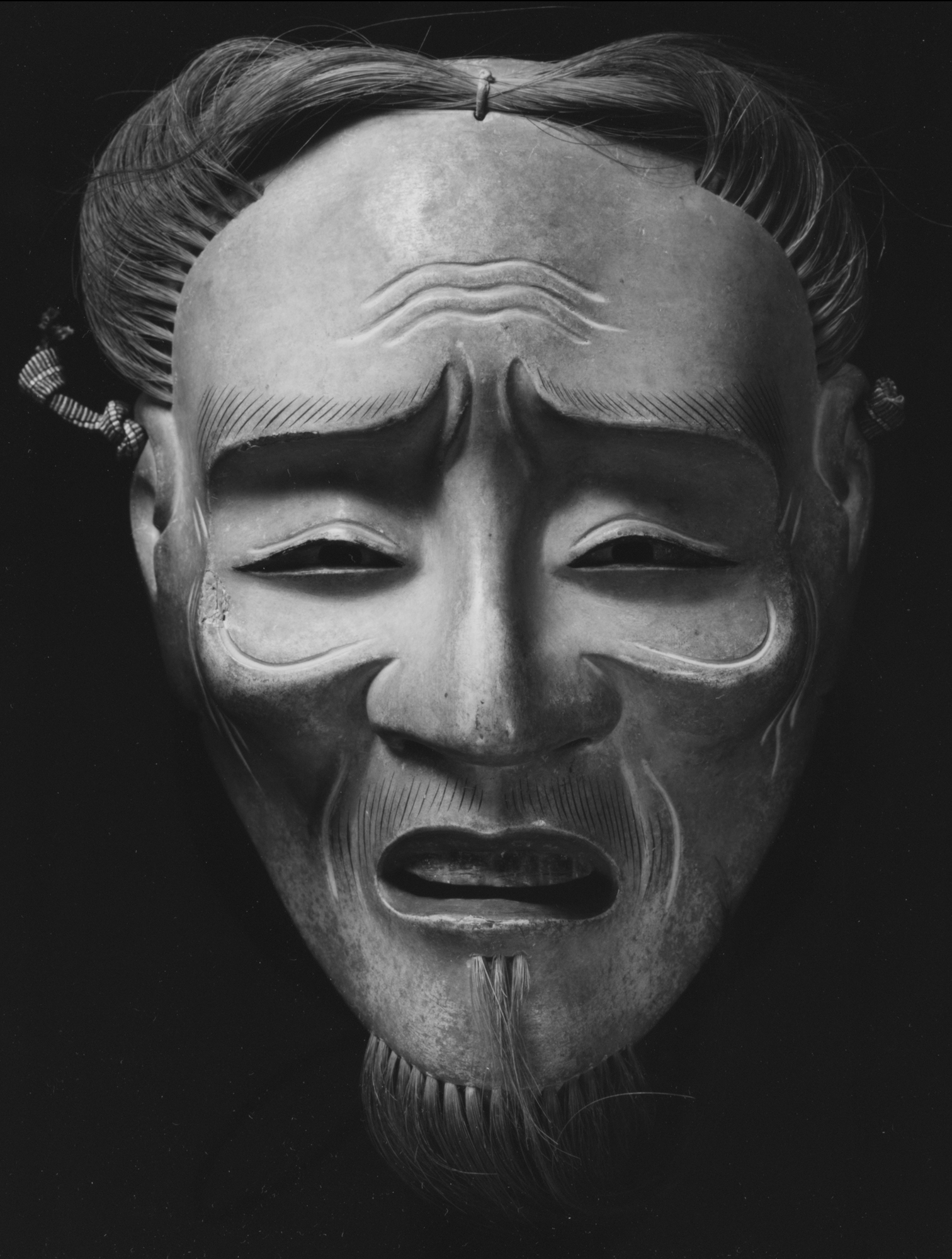Spellbinding Noh Drama at Kohfukuji Temple and Kasugataisha Shrine in Nara Vol. 1
2024/05/02
This post is in two parts. Please see Vol. 2 here.
Over the course of two days in May, outdoor Noh theatre is performed by four major Noh schools of Japan at Kohfukuji (Kofukuji) Temple and nearby Kasugataisha shrine. After the second world war, all outdoor Noh performances – “Takigi Noh” – modelled themselves on the ones originally staged at this temple in Nara in the ninth century, the first ever to be performed (at least, as far as records tell us). This Noh theatre is a Nara City Intangible Folk Cultural Property and today the performances are held annually, during the days and the evenings of the 3rd Friday and Saturday of May (see details below). This year, those dates are May 17th and 18th.

“Ko-omote” Noh Mask. 18th century. Cypress wood with white, black, and red pigments. Purchase, Lila Acheson Wallace Gift, 1993. The Metropolitan Museum of Art.
Noh is one of Japan’s oldest forms of theatre, finding its roots in the continental folk art of Sangaku (“miscellaneous arts”, which became “Sarugaku” – “monkey music” – in Japan). It was the boisterous and humorous circus-like entertainment of skits, mime, magic, masks, illusions, puppetry, and acrobatics, to the accompaniment of music. Performers were invited to religious ceremonies – and since their acts became part of the ceremonies they can be understood essentially as ritual arts. During the medieval period Sarugaku evolved (or was, perhaps, even more highly ritualised) into Noh, a more refined form of entertainment. It may have been ritualistically refined, but it was/is as spellbinding as Sarugaku must have been, in both senses of the word, and especially – but not only – in the fact it has a corpus of supernatural, ghostly dramatised tales. “Takigi Noh” is not named as such because it is performed by the light of bonfires (takigi). It is because once-upon-a-time sacred firewood was ritualistically offered to the Buddha at Kofukuji and the Sarugaku performers offered their acts on these occasions. But it must be said that the takigi aspect is appealing in a more immediate sense. The warm, flickering illumination enhances the mysterious ambience of the art of Noh and the otherworldly nature of its figures and tales – one need only take a look at these photos to get a sense of that. And while Sarugaku was associated with Shinto since it was usually offered to the non-Buddhist gods to ensure their protection, it was absorbed into the Buddhist services at Kohfukuji temple as an element of the larger Buddhist ceremonials rather than as a distinct entertainment event.

Noh Mask: Kojo (Old Man). 19th century. Wood with pigments and hair. Rogers Fund, 1925, The Metropolitan Museum of Art.
Essentially, Sarugaku was elevated into an art, in the sense that we think of art today, and today it is probably one of Japan’s most elegant and sophisticated forms of dramatic theatre. Its comic aspects were retained in Kyogen plays which offer interludes between Noh plays. It seems that what was performed previously was spare when it came to any theatrical elements, and that it was primarily the esoteric Buddhist movements and the “Old Man” Okina character – both of them “magical” elements – that were adopted into Noh. If you have seen Nara’s Omizutori ritual, you will know the role of the “Incantation Master” who, among other things, summons goblins. The spirit of magical practices is evident there – and it is present here too, in the early Sarugaku that changed into Noh, in the estoteric movements within Noh, and in the ancient figure of the “Old Man”. When the lead actor slips on the mask of Okina, he is turned into a deity.

Mask (perhaps military) modelled on Noh character, Okina. Possibly 15th century. Iron, lacquer, hair, textile (silk). Gift of Bashford Dean, 1914. The Metropolitan Museum of Art.
It seems extraordinary that what was originally a lively show of acrobatics and illusions could be developed in the fourteenth and fifteenth centuries into the refined, minimalist and somewhat culturally exclusive Noh theatre (and its gorgeous costumes and fine, understated masks) that we see today, but this is indeed the case – and the principle figures behind this development and elevation were playwright, actor, and troupe leaders father and son Kan’ami and Zeami, and then Konparu Zenchiku, who married Zeami’s daughter. Zeami created classic Noh. He was an early celebrity in the world of Japanese entertainment: his production of elegant plays based on historical and classical themes, as well as of the mysterious “mugen” genre, along with patronage by the Shogunate, lifted Noh out of the realm of the circus-like Sarugaku. Zeami was an esteemed public figure and intellectual, producing profound treatises on Noh acting (see, for example, the 14th century Style and the Flower).

The Auspicious Noh Dance “Okina”. Toriyama Sekien (Japanese, 1712–1788). ca. 1790–95. Scroll of Okina from triptych of hanging scrolls; ink, color, and gold on paper. Mary Griggs Burke Collection, Gift of the Mary and Jackson Burke Foundation, 2015. The Metropolitan Museum of Art.
The Sarugaku troupe that had long ago performed for Kohfukuji (and Kasugataisha) developed into today’s Konparu Noh troupe, and the Noh schools performing this May are the Kanze, Konparu, Hosho, and Kongo. The Okura school will be performing the Kyogen interludes. This is a treat for Noh specialists and enthusiasts, and a good introduction for those who are new to Noh.
To Be Continued in Vol. 2…
Takigi O-Noh Programme:
May 17th (Fri)
From 11am:
At Kasugataisha Grand Shrine, Konparu School of Noh performs Okina 翁
From 17:30: at Kohfukuji Temple, in front of the Site of the Southern Gate (Nandaimon).
・ Kanze School of Noh performs Utaura 歌占
・Okura School of Kyogen performs Enmeibukuro 延命袋
・Kongō School of Noh performs Toru 融
May 18th (Sat)
From 11am:
At Kasugataisha Grand Shrine Wakamiya, Konparu School of Noh performs Ukai 鵜飼
From 17:30: at Kohfukuji Temple, in front of the Site of the Southern Gate (Nandaimon).
・Konparu School of Noh performs Toboku 東北
・Okura School of Kyogen performs Neongyoku 寝音曲
・Hosho School of Noh performs Kannawa 鉄輪
Where: At Kohfukuji Temples’s Hannya Shiba lawn at the Nandaimon Gate (here), and at Kasugataisha’s Buden (Dance Hall) (here) and Wakamiya Shrine (here).
Access:
Kasugataisha Grand Shrine
8 minutes by bus to to “Kasuga Taisha Honden” from JR Nara and Kintetsu Nara Stations. Alight at the final stop on the bus (“Kasuga Taisha Honden”). Or 8 minutes on the city loop bus. Alight at “Kasuga Taisha Omotesando” bus stop and walk for 10 minutes.
Kohfukuji Temple
A 5 minute walk from Kintetsu Nara Station.
Admission:
Tickets for Kasugataisha: Sponsor Seats 6,500 yen per person. There are only Sponsor Seats available and no free standing/sitting space
Tickets for Kohfukuji: Sponsor Seats 6,500 yen per person OR free (standing only)
All seats in the venues are non-reserved. Tickets are available for purchase on a first-come first-served basis on the day at the entrance to the venues, and are valid for only one day.
In the case of rain, the (evening) Nandaimon-no-Gi may be moved to the Nara Bunka Kaikan (International Hall, Nara Prefecture Culture Hall) but please keep an eye, on the day, on the Nara City Tourist Association Facebook page for any changes in venue.
Please note that photography, video and mobile phone recording are not allowed.
Please feel free to contact us here at Kansai Treasure Travel anytime for further details, travel advice, or a custom tour and see our 1 Day Nara and Uji Private Tailor-made Tour
![[Day Trip] 1-Day Nara and Uji Private Tailor-Made Tour](https://nara-sightseeing.com/ns/wp-content/uploads/2020/02/byoudouin.jpg)
This course is a tour that takes you from Osaka to Nara, famous for deer and the Great Buddha; and to Uji City, which is famous for tea. An English-speaking driver will go to pick you up at your hotel in Osaka.
from99,000JPY

01
FIND YOUR FAVORITE
TRIP ON OUR WEBSITE.
SEND US AN INQUIRY.

02
PERSONALIZE THE TRIP
TO YOUR INTERESTS
WITH OUR CONSULTANT.

03
20% DEPOSIT TO CONFIRM.
BALANCE PRIOR TO ARRIVAL.
PAYMENT BY CC OR TT.

04
WE WILL
MEET YOU
AT THE AIRPORT.

05
DISCOVER THE
TREASURES!